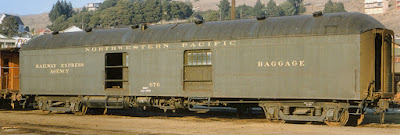Brake wheels on model freight cars have to be replaced on occasion, usually because either the wheel itself gets broken, or with vertical-staff brakes, the staff is broken. The latter is very common on ready-to-run models with plastic brake staffs, which are fragile and quite vulnerable to damage even when carefully handled. I recently did several of these replacements.
The vertical-staff brakes in a kit may be of the type with a plastic brake wheel, with a metal wire staff. These too are vulnerable, and I usually replace the wheels during construction. In fact, I like to keep some pre-built replacement parts around, created by soldering a Cal Scale brass brake wheel to brass wire. Then I have these on hand whenever needed. Usually I solder a wheel to each end of a piece of wire:
Then when a replacement is needed, I just cut one end of such assemblies to suitable length.
One example is the InterMountain ready-to-run tank cars. The plastic brake staffs rarely survive more than a couple of operating sessions. Here is the kind of replacement I make, using brake assemblies like those shown in the photo above (obviously still to be painted black):
I also use the soldered wheel-staff assemblies when building any tank car kit. As an example, here is the new brake staff on an Athearn tank car underframe (replacing the rather improbable vertical-wheel arrangement provided by Athearn). The gray material is Tamiya putty, filling in the hole intended to hold the Athearn brake assembly.
As stated, I make some of the brake wheel-staff assemblies long enough to use on house cars that need them. This example is an Accurail reefer body, which will now have a far sturdier brake wheel.
Another situation is a model freight car which has had its brake wheel broken in service, though not a vertical-staff example like those above. For those, I dig into my stash of brake wheels and try to find one that matches what was there before, or what the prototype should have.
An example is my Funaro & Camerlengo T&NO War Emergency 40-foot gondola. It experienced a collision with another model and damaged the brake wheel. (Additional damage is visible on the top chord of the end.) I removed the damaged wheel and replaced it with a Kadee Ajax wheel, a very nice part. The car, T&NO 42578, would be a member of Class G-50-17, built with Klasing hand brakes; but in later years, SP and T&NO tended to replace any damaged hand brakes with Ajax. Thus my replacement is characteristic of the prototype.
Brake wheels are just one of the many maintenance issues that can arise with model freight cars. I find that I get brake wheel replacements taken care of more quickly if I have the soldered wheel-staff assemblies on hand, and just attach them where needed.
Tony Thompson














































